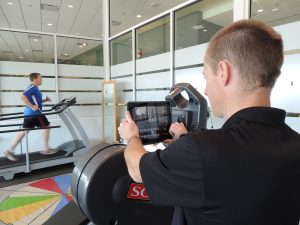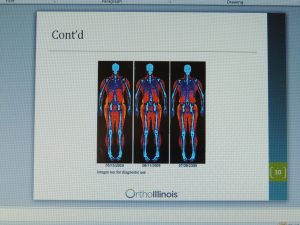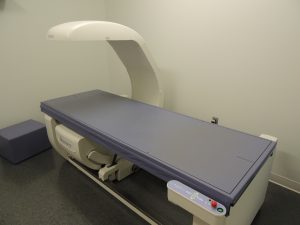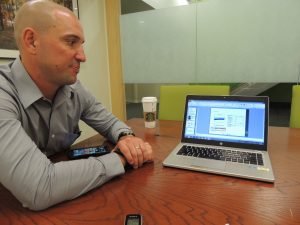Programs take the sting out of summer shape-up
By Lynne Conner For Chronicle Media — June 16, 2016
Jonathan Gallas demonstrates the BikeRight program while student physical therapist Brittnay Reed films his performance on an iPad.
Strains, sprains and sore muscles are the main reasons most adults hesitate to start or restart a fitness regimen.
With the summer season of shorts and bathing suits now upon us, OrthoIllinois in Rockford has several programs that can help those wanting to get back into shape or improve their current fitness performance.
Taylor Riley, a physical therapist with OrthoIllinois, said that anyone beginning a fitness program should first get a check-up with their primary-care physician to discuss any medical concerns prior to strenuous exercise.
“If you have any nagging issues like a knee that always seems to flare up or an ankle that always seems to get tweaked (by exercise), talk to your physician to get a referral for physical therapy which can address underlying issues.”

Jonathan Gallas leads RunRight client, Matt Denning through some exercises as part of the RunRight program.
Riley said that strengthening weak muscles before starting a full-on fitness program can help performance and stamina in the long term. He suggests starting with some “dynamic stretching” right before a workout.
“Most people try and do a static stretch like, for example, that long hamstring hold that runners do. That’s good for after exercising because it actually calms the muscle down and reduces its ability to ‘fire’ for about 24 hours,” he said. “If you do this static stretch after exercise, you will have a reduction in muscle cramps.”
Riley said that OrthoIllinois patients can receive additional information on what types of stretching would be most useful to their chosen exercise. He also suggests getting plenty of rest, eating healthy, icing affected muscles and using a therapeutic foam roller to minimize soreness after working out.
Preventing injuries before they happen is the focus of RunRight and BikeRight, two innovative new programs at OrthoIllinois. Each program utilizes computer and video technology and the expertise of a specially trained physical therapist to analyze a cyclist’s or runner’s performance. Based on the information collected, the physical therapist will then make recommendations on how the cyclist or runner can improve their performance to maximize their workout. Some components of RunRight and BikeRight include: flexibility and strength training screening, counseling on injury diagnosis and equipment recommendations or modifications.

Jonathan Gallas, a physical therapist at OrthoIllinois uses an iPad to take a video of Matt Denning, a RunRight client.
“If you are really interested in getting back into running or biking, these programs can help you avoid injuries by … getting you set up with the proper bike height and seating position … . A RunRight evaluation will look at your functional performance while running, shoe wear … and cadence changes that may need to be made,” Riley said. “From a physical therapy standpoint, we usually see an individual who’s already tried to get back into biking or running without the ‘first step’ approach that BikeRight or RunRight would offer and they come in with injuries.”
Jonathan Gallas, a physical therapist with OrthoIllinois manages the RunRight and BikeRight programs and is a certified bike physical therapist. According to Gallas, an avid runner and triathlete himself, the RunRight program began in 2013 as a way to help runners prevent injuries by analyzing how they run.
“RunRight helps us comprehensively treat the runner instead of just giving them medication or sending them to physical therapy. We can help them perform their activity better, work on strength, flexibility and balance and help them correct what they may be doing wrong. The RunRight and BikeRight programs are all about preventing injuries and maximizing performance,” he said.
Gallas sees these programs benefitting adults of any age.
“There are really two types of people who would qualify as good candidates for the RunRight program. One would be somebody who wants to improve their performance and isn’t injured. By modifying their gait and helping them land a little differently or improving their flexibility and strength, they can be faster. The other type of person that would benefit from RunRight is someone who has been injured and has hip, knee or foot pain. In this case, we may look at their shoe type, see how they are loading from side to side and make suggestions based on our findings.”
The RunRight and BikeRight programs are currently only available at OrthoIllinois in Rockford, though the company has a facility in Crystal Lake. The BikeRight program consists of two sessions and costs $150. Gallas points out that the cost of BikeRight is far less than doctor visits and physical therapy sessions after a person is injured.
A participant in the BikeRight program would bring in their own bike, which is placed on a special bike trainer prop. As the person begins to ride, the bike trainer’s Bluetooth technology records speed, cadence and other variables and sends them to Gallas’ iPad for further analysis.
“We will usually have the person do a performance trial on the bike, riding vigorously for three to five minutes,” he said. “This tells us what their maximum performance output is. While they are riding, I will take some video to see what is going on with their positioning on the bike, how much knee bend they have, how far forward the seat is and how high the handlebars are.”
Once Gallas has processed this information, he has the BikeRight client make adjustments to their position on the bike or to the bike itself. A second video is then recorded with these adjustments so the client can see a change in their performance.
“Typically, they can see a difference in their output; their speed is better even though they are maintaining the same cadence all because they may have changed their positioning on the bike,” he said.

A body scan analysis print-out using the Dexa machine at OrthoIllinois. The print-out is color coded to differntiate fat, muscle and bone. (Photo by Lynne Conner/for Chronicle Media)
The bike training prop used in the BikeRight analysis can also be set to mimic the feel and resistance of an actual road. After participating in BikeRight or RunRight, the client is given a PDF file of their results for future reference.
Matt Denning of Roscoe did a RunRight evaluation after having knee surgery. In recovering from the surgery, he began experiencing knee pain after running and saw the program as an alternative to quitting one of his favorite past times.
“I’m now running without pain and running more efficiently than I did before. I’m also stretching way more than I used to because I wasn’t stretching correctly,” he said.
Denning is now working on building up lower body muscle and flexibility.
Body Composition Analysis (BCA) using a Dexa machine is a new method offered by OrthoIllinois for those wanting to improve their overall health and fitness.
“This is a means of accurately measuring one’s body composition to determine an individual’s percentage of fat, lean body mass and bone mass,” said David Rezin chief operations officer at OrthoIllinois in explaining the Dexa. “The scan can also break down these percentages for the head, trunk and limbs.”
According to Rezin, in a typical Dexa scan the client will lie down on an exam table, fully clothed with any metal jewelry removed. The Dexa machine does a full body scan of the person using a low-dose X-ray to differentiate fat, muscle and bone mass. The scan takes only a few minutes and the client is given a printed summary of their body composition immediately following the scan.
“The summary gives a nice breakdown of where your fat percentage is, where you have muscle percentage and where bone mass is,” Rezin said. “The Dexa summary not only gives you an individual breakdown of your fat, muscle and bone percentages, it also gives you an age-related mean, taking into consideration your age and gender. Of course, everyone wants their fat percentage to be low, but we also have to keep in mind what’s realistic for a given age range.”
A Dexa scan could be very beneficial to those trying to get into shape or to those who wish to improve their current fitness standard. Priced at $49.95 for the initial scan and $34.95 for subsequent scans, Dexa proves to be cost effective as well.
Whether beginning, restarting or trying to improve individual fitness levels the BikeRight, RunRight and Dexa scan offerings at OrthoIllinois are reliable and cost conscious ways to optimize workouts and reduce the dreaded strains, sprains and sore muscles that block the road to fitness.
— Programs take the sting out of summer shape-up —









